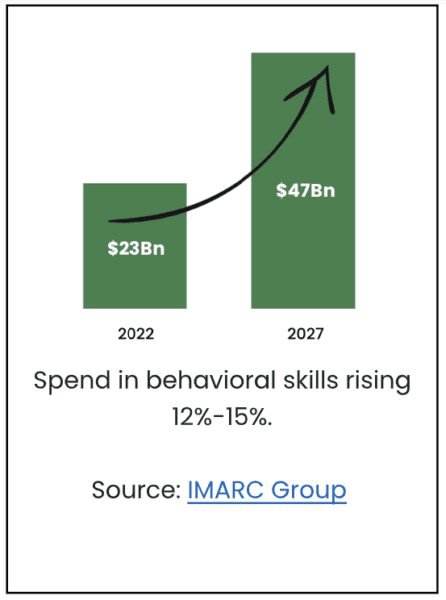There’s a growing realization that successful digital and business transformation is not about just technology. It’s as much about the ability of a workforce to embrace change and new ways of thinking and operating. It’s about behavior change, and that’s the tough part — the thing that keeps business leaders awake at night.
Some organizations succeed. Their secret is rethinking three fundamental aspects of workforce development:
- What gets trained.
- Who gets trained.
- How to measure.
Research from McKinsey, Deloitte, PwC, Harvard Business School and others highlights how now is the time for bold moves in people strategy. In this article, we explore how three different organizations — Tata Tele Business Services, SAP and Kuok Group — are making the right moves.

What gets trained
After a decade of focusing on digital and technical training, there are clear signs budgets are shifting toward soft skills. In reality, they are the hardest to acquire.
The pandemic and ongoing economic and political uncertainty underscore the importance of human skills — the ability to influence; collaborate across diverse, distributed teams; communicate effectively and be adaptable — in meeting the demands of an agile, volatile and competitive marketplace.
By its nature, digital transformation has a starting point, but it is a journey without an endpoint. In this context, a workforce needs to develop the following mindsets:
- Self-awareness to recognize that constant change means who you are today may need to morph to be relevant tomorrow. Becoming more self-aware is the first step toward overcoming vulnerabilities — which is often what holds an individual back from embracing the “new.”
- Curiosity for learning driven by a strong “what’s in it for me” mentality and understanding the empowerment and confidence boost that comes from acquiring new skills.
- Behaviors that lead to a growth mindset, where there is an openness to new ideas and an ability to collaborate with colleagues with diverse minds and backgrounds so the best ideas and solutions to problems can be uncovered.
Acquiring these traits creates a talent pool that isn’t afraid to embrace the new and unknown. With these mindsets we are able to see digital transformation as a powerful accelerator to a better world.
Developing these skills is a challenge because they are a cocktail of multiple other skills, and a person must understand the context of why they matter. It requires reflective learning that gets everyone to slow down and intentionally and mindfully focus on themselves. That’s not easy in an always-on and distracted world.
Who gets trained
Current soft skills learning strategies are trapped in legacy competency frameworks that have their roots in the Industrial Revolution’s command-and-control structures. Most learning teams assign learning topics based on an employee’s “band,” experience level or role.
But competency handcuffs have no place when it comes to tackling the mindsets and behaviors needed for successful digital transformation that cuts across an organization. There is little point in only training 10 percent of a workforce on how to improve communication and work collaboratively across distributed teams if the other 90 percent continues to do as it’s always done.
What’s needed is a set of consistent day-to-day operating mindsets and values and the skills that will help deliver outcomes across everyone in the organization regardless of role and rank. Training the integrated set of behaviors needed for digital transformation should be based on an inclusive strategy that embraces the whole workforce.
“We’ve trained cross-functional
Nitin Prakash, deputy GM of
teams and seen fantastic feedback
and results. The learning is sticking.”
learning & development, Tata
Tele
At India’s Tata Tele Business Services, 80 percent of the workforce has undergone behavioral skills training and all new hires complete a three-month structured soft skills program where outcomes are measured. This calculated strategy to develop relevant future skills in what was, until 2019, a legacy telecommunications operator has helped transform Tata Tele into one of the most dynamic and financially top-performing units of the Tata Group. Modern professional behavioral skills improved 60 percent through this initiative. Starting at the top with general managers and then cascading through cross-functional teams, Tata Tele established a strong learning culture as the foundation of its digital transformation agenda.
Tata Tele’s learning team has systematically added more learning initiatives. This success has been possible because the foundational learning culture was set across all levels of Tata Tele’s workforce and gained mass participation.
Whether you are a legacy software giant, an auto manufacturer or a digital-first business such as e-commerce, the mindset shift needed goes well beyond the C-suite or board; new mindsets must permeate and gain momentum for this reengineering to drive transformation.
Another established business transforming its people and organization is Kuok Singapore Limited Group — a diversified Asian conglomerate established in 1949 in Malaysia. KSL operates globally across digital infrastructure, maritime and real estate. Employees in customer-facing roles, technology, finance, administration, HR and other functions are given opportunities as cross-functional and cross-business teams to learn a consistent set of soft skills and behaviors in cohorts. This signals an inclusive approach to developing critical soft skills for the new world of work. All new hires are enrolled as part of their induction to learn how to incorporate and live the KSL’s core values and behaviors.
At German technology giant SAP, there’s still a big focus to upskill technical capabilities and increase digital skills among its 110,000 workers. At the same time, there’s also an effort to support the mindset and behavioral development of SAP’s people so they can be confident in the agile new world and remain relevant in Industry 4.0.
“Product knowledge and selling techniques are a must for our associates. But they also
Doug Robertson, VP, SAP Presales Academy
need to build strong human connections and relationships, think critically in real time
when meeting customers, communicate benefits and not just features of our great
solutions, and uncover customer problems fast.”
Efforts go beyond training just engineering and software developers. Staff in pre-sales, the first point of contact with customers, have a structured learning program for soft skills that offers certification integrated into their year-long training on SAP solutions, product and industry knowledge.
What to measure
The third rethink is how to link the investment in soft skills training to business outcomes. Shockingly, though technology enables powerful people analytics and intelligence that measures learning Impact, most learning strategies hide behind vanity metrics such as:
- “We launched 7,000 hours of new learning.”
- “Employees completed five hours of learning each this quarter.”
- “Forty percent of employees activated and accessed our learning library (Udemy/Coursera/LinkedIn Learning, etc.)”
What’s common to all these? They measure input, not output or outcomes.
Unlocking data so meaningful business insight can be derived to drive business outcomes is a key tenet of digital transformation. What better umbrella, therefore, than digital transformation bringing accountability to learning strategies!
The companies mentioned here and several others, including PwC, Kyndryl and Deloitte, are all introducing greater data analysis that strengthens the impact of their soft skills training investments. There’s no question that measuring the efficacy of behavioral skills development is harder to do than measuring the ability of an employee to create pivot tables or their fluency in machine learning. But the tools exist to track and measure learning outcomes.
Following are important measures to track:
- Confidence gain: Mindset shift requires individuals to overcome fear and feeling vulnerable about change. Measuring how behavioral skills training impacts confidence is vital but often overlooked. Organizations that capture and analyze this data see an average bump of up to 60 percent in confidence from pre-training to post-training when behavioral change programs last at least three months. Duration is key as it’s unrealistic to see mindset change from TikTok moments.
- Relevance: Offering a strong “what’s in it for me” lends purpose to developing new mindsets and traits, especially since it’s hard for most adults to recognize their blind spots and shed long-held biases and habits. The companies mentioned in this article are seeing an average relevance-to-job rating of 9.4 out of 10. Not only does this mean there’s a strong “pull” factor that ensures employees complete the learning because they see its relevance, but it also means learning and development teams have cracked the code in meeting what their “customer” wants.
- Skills gain: Create a baseline for individuals and teams. Measure not just post-training but at regular intervals during the learning journey as well as three to six months later. Lots of factors can affect skills gain, including experience level, industry and role, so apply the appropriate lens when gauging the true gain.
- Full course completion: How many employees completed their training in full? Get detail on course length and how it was rolled out. Was this a 20-minute micro session or was it staged? Getting learning to stick and change an adult’s behavior requires time and effort. Soft skills course completion rates are notoriously low. Most organizations see abysmal stats where fewer than 15 percent of all those given access to a content library online finish the training.
- Aim for 100 percent: Seek to have your entire workforce certified in the high-performance soft skills that deliver digital transformation. Remember that scale matters in any transformation. How can there be impact if only 2 percent of your population gets trained to think critically and develops these skills and traits?
Mass participation sends a powerful message. It communicates to the whole organization the importance and value placed on new behaviors, ways of thinking and ways of doing. For those who take an inclusive approach by training 100 percent of their workforce in the human skills needed today, digital transformation comes quicker and comes to stay.
Thinking about digital transformation — not solely through the lens of technology, but as an issue of culture and mindset change — will improve your chances of success.















